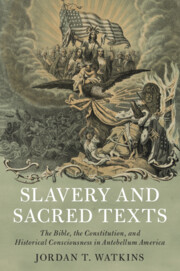 Slavery and Sacred Texts
Slavery and Sacred Texts Published online by Cambridge University Press: 12 June 2021
This chapter narrates African American historian William C. Nell’s efforts to highlight the actions of black Revolutionaries. His focus on figures such as Crispus Attucks, rather than static texts, such as the Constitution, laid claim to the first American Revolution in a way that signaled the need for a second revolution. While emphasizing instances of black assertiveness, Nell also narrated the instantiation of white prejudice. This indicated the promise of contingent change: if the human actions of the post-revolutionary period had betrayed the human actions of the revolutionary era, then new revolutionaries could reconstruct the current proslavery and prejudicial context and grant black contemporaries the rights for which their forebears fought. This interpretive frame inspired black reponses to Dred Scott, including the creation of Crispus Attucks Day. The Attucks commemorators crafted historical arguments to confront the racial prejudice they identified in both Roger B. Taney’s decision and in fellow abolitionist Theodore Parker’s speeches, and they looked to the first American Revolution to envision a second revolution in which blacks would play starring roles.
To save this book to your Kindle, first ensure [email protected] is added to your Approved Personal Document E-mail List under your Personal Document Settings on the Manage Your Content and Devices page of your Amazon account. Then enter the ‘name’ part of your Kindle email address below. Find out more about saving to your Kindle.
Note you can select to save to either the @free.kindle.com or @kindle.com variations. ‘@free.kindle.com’ emails are free but can only be saved to your device when it is connected to wi-fi. ‘@kindle.com’ emails can be delivered even when you are not connected to wi-fi, but note that service fees apply.
Find out more about the Kindle Personal Document Service.
To save content items to your account, please confirm that you agree to abide by our usage policies. If this is the first time you use this feature, you will be asked to authorise Cambridge Core to connect with your account. Find out more about saving content to Dropbox.
To save content items to your account, please confirm that you agree to abide by our usage policies. If this is the first time you use this feature, you will be asked to authorise Cambridge Core to connect with your account. Find out more about saving content to Google Drive.